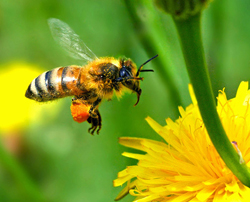Loss of bees could be 'a blow to UK economy'
 If bees and other pollinators were to disappear completely, the cost to the UK economy could be up to £440m per year, scientists have warned.
If bees and other pollinators were to disappear completely, the cost to the UK economy could be up to £440m per year, scientists have warned. This amounts to about 13% of the country’s income from farming.
In a bid to save the declining insects, up to £10m has been invested in nine projects that will explore threats to pollinators.
The Insect Pollinators Initiative will look at different aspects of the insects’ decline.
The initiative brings together specialists from a number of UK universities, as well as from the Food & Environment Research Agency and the Natural Environment Research Council’s (Nerc) Centre for Ecology and Hydrology.
It is funded by several public and charity organisations, led by the Biotechnology and Biological Sciences Research Council.
Honeybees, hoverflies, wasps, bumblebees, moths and butterflies play a vital role in feeding people through the pollination of crops.
Speaking at a news briefing at the Science Media Centre, Professor Andrew Watkinson, director of the Living with Environmental Change programme, said that the new initiative “allowed us to bring in new skills in gene sequencing and epidemiological modelling with the expertise that already exists in the pollinator research community”.
Some projects will look at factors affecting the health and survival of pollinators in general. Others will focus on specific species and diseases.
‘Catastrophic’ decline
Professor Watkinson said there was no single factor that could explain the pollinators’ decline.
“There’s a whole range of agriculture and land use, disease, environmental change [and] pesticides,” he said.
“To tackle a complex problem like the decline of pollinating insects, where there are a number of potential causes, requires wide-ranging research.”
For some species, such as bumblebees, the decline was “catastrophic”, he added.
“It’s really difficult to quantify [the extent of the decline of pollinators] and that’s one of the problems we really need to address.
“What we need is some robust science and I think that this programme is going to provide it.”
Another speaker, Claire Carvell from the Centre for Ecology and Hydrology, said that since the 1970s, there had been a 75% decline of butterfly species in the UK.
Also, out of 25 species of bumblebees, three had gone extinct, she added.
These “extra special” bees with large hairy bodies are very effective at transferring pollen between flowers, she commented.
“They are also active at lower temperatures than other bees, so you’ll see them out working earlier and later in the day.
“But bumblebees have declined worldwide, largely due to the loss of flowers and other habitats they need to survive in the countryside.”
Dr Carvell said that her team will use a method of collecting DNA from live wild bumblebees to estimate how far queen bees fly to start new nests and how far workers fly to forage.
“These findings will allow us to manage landscapes in ways that are effective in conserving bumblebee populations,” she concluded.
A brain disorder?
Neurobiologist Chris Connolly, of the University of Dundee, is leading research into the effect pesticides have on bees.
In particular, his team will assess any possible damage to the insects’ abilities to gather food, navigate and even perform their special “waggle dance”, which they use to let other bees know where nectar can be found.
He said that the pollinators’ decline could be partially explained by a brain disorder - triggered by chemicals in pesticides.
“A single pesticide or miticide is not likely to be responsible… but a cocktail of different pesticides or miticides might [have a combined effect] to amplify the brain problem,” explained Dr Connolly.
His study will concentrate on identifying these dangerous combinations on order to advise farmers on avoiding them in the future.
It will include fitting tiny radio frequency ID tags on pollinators wich will act like “barcodes at the supermarket”, recording when insects enter and leave the nest.
Other projects include investigating ecology and conservation of pollinators in cities, researching the impact of the mite Varroa destructor and the effects of agriculture on bees.
The vital thing, Professor Watkinson stated, was for the scientists to communicate the results of their studies to the people in the field - beekeepers and farmers.
“It is imperative that the science that’s being done is fed through as quickly as possible to the conservationists, to the agricultural community, so that we can ensure food security and also the maintenance of our biodiversity,” he said.
By Katia Moskvitch
Science reporter, BBC News
BBC News website
You can return to the main Market News page, or press the Back button on your browser.

